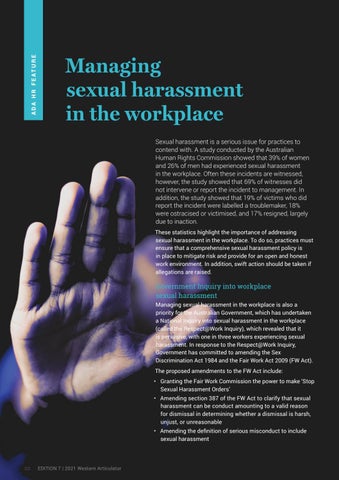ADA HR FEATURE
Managing sexual harassment in the workplace Sexual harassment is a serious issue for practices to contend with. A study conducted by the Australian Human Rights Commission showed that 39% of women and 26% of men had experienced sexual harassment in the workplace. Often these incidents are witnessed, however, the study showed that 69% of witnesses did not intervene or report the incident to management. In addition, the study showed that 19% of victims who did report the incident were labelled a troublemaker, 18% were ostracised or victimised, and 17% resigned, largely due to inaction. These statistics highlight the importance of addressing sexual harassment in the workplace. To do so, practices must ensure that a comprehensive sexual harassment policy is in place to mitigate risk and provide for an open and honest work environment. In addition, swift action should be taken if allegations are raised.
Government Inquiry into workplace sexual harassment Managing sexual harassment in the workplace is also a priority for the Australian Government, which has undertaken a National Inquiry into sexual harassment in the workplace (called the Respect@Work Inquiry), which revealed that it is pervasive, with one in three workers experiencing sexual harassment. In response to the Respect@Work Inquiry, Government has committed to amending the Sex Discrimination Act 1984 and the Fair Work Act 2009 (FW Act). The proposed amendments to the FW Act include: • Granting the Fair Work Commission the power to make ‘Stop Sexual Harassment Orders’ • Amending section 387 of the FW Act to clarify that sexual harassment can be conduct amounting to a valid reason for dismissal in determining whether a dismissal is harsh, unjust, or unreasonable • Amending the definition of serious misconduct to include sexual harassment
32
EDITION 7 | 2021 Western Articulator















